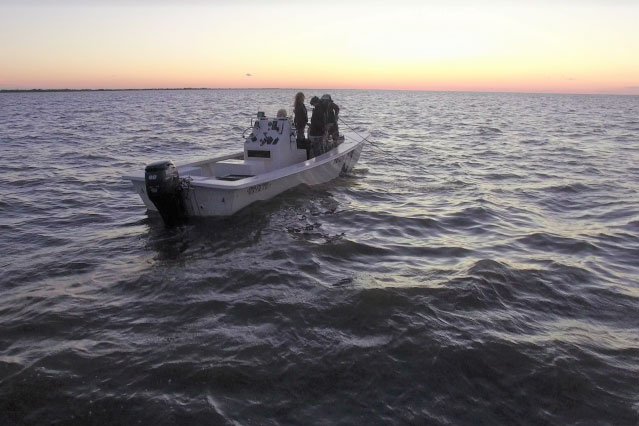Texas A&M Galveston Doctoral Student Tagging Bull Sharks in Galveston Bay
A doctoral student in the Shark Biology & Fisheries Science Lab at Texas A&M University at Galveston is studying the movement and habitat patterns of bull sharks in Galveston Bay with support from Texas Sea Grant’s Grants-In-Aid of Graduate Research Program.
Thomas TinHan is tagging juvenile bull sharks (Carcharhinus leucas) to learn more about their habitat preferences through long- and short-term movement tracking. Texas estuaries are essential nursery habitats for the sharks, but these areas vary greatly in habitat type and regularly experience drastic changes in environmental conditions like temperature and salinity. By tagging the sharks and then observing where they go over time, TinHan hopes to learn more about how they respond to these changes. “I’ve always had an interest in studying the behavior of apex predators,” he said. “They typically play very important roles in marine ecosystems.”

Texas A&M University at Galveston doctoral student Tom TinHan releases a freshly tagged juvenile bull shark back into east Galveston Bay (Photo by Travis Richards).
By studying one of the top predators in Galveston Bay, TinHan said that more can be learned about the food chain as a whole, which can then be used to inform management and fishing practices in Texas bays. “Some ecosystems are very tightly linked,” he said. “If you adjust the population of one species it could affect several other species, or it might not. But it’s important we understand how much influence that might have, and the first step of getting at that is understanding the first link in the chain.”
TinHan has long been fascinated by sharks. He volunteered at the University of Hawaii’s shark lab studying tiger sharks and hammerheads while working toward his undergraduate degree in marine biology. He has a specific interest in bull sharks because they are infamous for their ability to do something that very few other sharks can do: regularly travel deep into freshwater systems with no apparent ill effects. Bull sharks are uniquely adept at regulating the salt content in their bodies, and their tolerance for varied salinity grows with their size.
TinHan said that spending time in fresh water may be a trade-off, especially for smaller sharks. “The lower the salinity, the more energy it takes them to regulate that,” he said. “But because fewer species can inhabit low salinities, juveniles can go up into those habitats and remain relatively unthreatened by larger sharks.”

As the sun sets on Galveston Bay, Texas A&M University at Galveston doctoral students Tom TinHan, Phil Sanchez and Travis Richards deploy entanglement nets to capture bull sharks.
He added that being in fresh water reduces a shark’s buoyancy by about eight times, making it far more taxing for it to swim when the salinity is low. But for small sharks, it is thought that all of these extra energy expenditures are preferable to being eaten.
Bull sharks have been found all over the world in rivers and lakes that are connected to oceans, but the extent to which they do this in Texas isn’t well known. “Texas Parks and Wildlife has a coastal monitoring program that’s been going on for about 30 years, but they don’t sample into freshwater systems,” TinHan said. “We know that bull sharks move into low salinity areas near river mouths, but we don’t know how far they’re actually moving into them.”
He adds that it’s not rare for bull sharks to be found in fresh bodies of water in Texas, but how often it happens is hard to quantify. “Fishermen who are attempting to catch other species in rivers will catch bull sharks occasionally, but it’s hard to tell how often it happens because they’re typically not fishing for an animal that large, so bite-offs are common.”
TinHan hopes that observing the sharks’ movement patterns over the course of a year will shed some light on that mystery and provide a clearer picture of why they spend their time where they do. He will track the sharks by fixing each animal that is caught with an acoustic transmitter. These tags send out a signal every few minutes that can be picked up by the listening stations his team has scattered throughout different habitats in Galveston Bay.
TinHan began tagging sharks during summer 2017 in part with the aid of Texas Sea Grant’s funding, but his project was interrupted by Hurricane Harvey in late August. However, tagging has since resumed, and TinHan said they plan to deploy another 20-30 tags before next summer. The team will begin monitoring the sharks’ movements for a full year after the last tag is deployed.
For more information about research at the Shark Biology & Fisheries Science Lab, visit https://www.tamug.edu/wellsfisherieslab/.